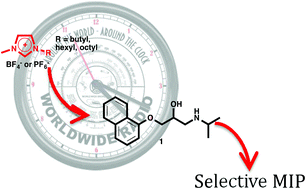Ionic liquids as porogens for molecularly imprinted polymers: propranolol, a model study†
Abstract
The selectivity and rebinding capacity of molecularly imprinted polymers selective for propranolol (1) using the room temperature ionic liquids [BMIM][BF4], [BMIM][PF6], [HMIM][PF6] and [OMIM][PF6] and CHCl3 were examined. The observed IF (imprinting factor) values for MIPBF4, MIPPF6 and MIPCHCl3 were 1.0, 1.98 and 4.64, respectively. The longer chain HMIM and OMIM systems returned lower IF values of 1.1 and 2.3, respectively. MIPPF6 also showed a ∼25% binding capacity reduction vs. MIPCHCl3 (5 μmol g−1vs. 7 μmol g−1 respectively). MIPCHCl3 and MIPPF6 differed in terms of BET surface area (306 m2 g−1vs. 185 m2 g−1), pore size (1.10 and 2.19 nm vs. 0.97 and 7.06 nm), the relative number of pores (Type A: 10.4 vs. 7.5%; Type B: 8.5 vs. 3.0%), and surface zeta potential (−37.9 mV vs. −20.3 mV). The MIP specificity for 1 was examined by selective rebinding studies with caffeine (2) and ephedrine (3). MIPPF6 rebound higher quantities of 2 than MIPCHCl3, but this was largely due to non-specific binding. Both MIPCHCl3 and MIPPF6 showed a higher affinity for 3 than for 2. Reduction in the Room Temperature Ionic Liquid (RTIL) porogen volume had little impact on the polymer morphology, but did result in a modest decrease in IF from 2.6 to 2.3 and in the binding capacity (30% to 19%). MIPCHCl3 retained the highest template specificity on rebinding from CHCl3 (IF = 4.6) dropping to IF = 0.6 in MeOH/[BMIM][PF6]. The MIPCHCl3 binding capacity remained constant using CHCl3, CH2Cl2 and MeOH (46–52%), dropped to 6% on addition of [BMIM][PF6] and increased to 83% in H2O (but at the expense of specificity with IFH2O = 1.4). MIPPF6 rebinding from MeOH saw an increase in specific rebinding to IF = 4.9 and also an increase in binding capacity to 48% when rebinding 1 from MeOH and to 42% and 45% with H2O and CH2Cl2, respectively, although in the latter case the increased capacity was at the cost of specificity with IFCH2Cl2 = 1.2. Overall the MIPPF6 capacity and specificity were enhanced on addition of MeOH.


 Please wait while we load your content...
Please wait while we load your content...